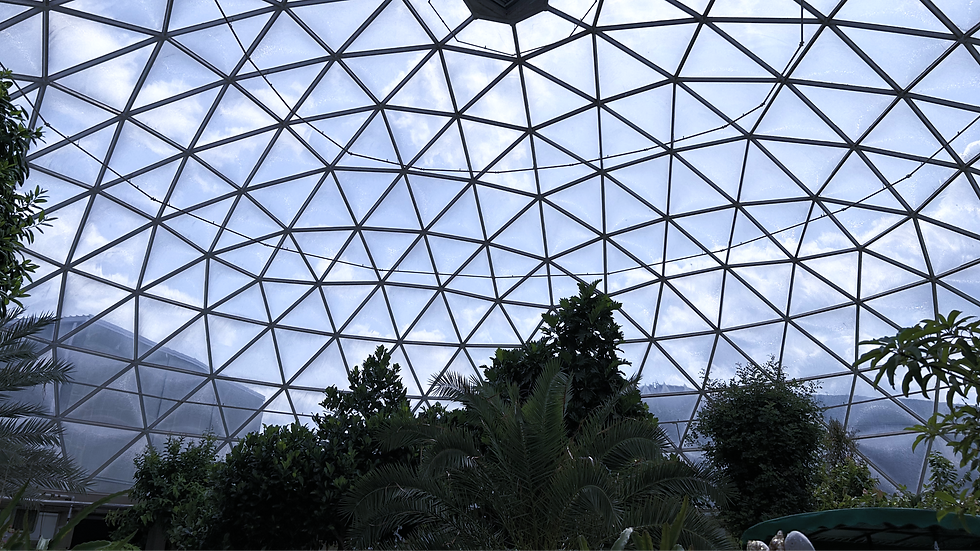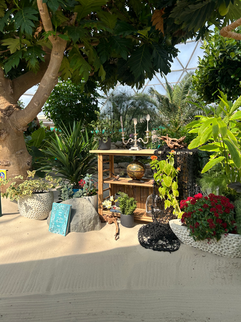This article includes affiliate links that help support MorgsMagic.
Have you ever taken a relaxing boat ride on Living with the Land, only to have the sudden desire to get out of the ride vehicle and prance around the greenhouse? First, I suggest resisting the urge to leave the boat as that is a one-way ticket to the park exit. Then, I would advise you to book the Behind the Seeds Tour which gives you an up-close and personal backstage walking tour of The Land Pavilion.

Ever since I saw the first tour group walking the grounds from the boat while on the Living with the Land attraction, the Behind the Seeds Tour has been on the top of my Walt Disney World bucket list. With this being my first solo trip coinciding with the International Flower and Garden Festival, I felt this was the perfect time to try it out!
Behind the Seeds Tour Overview
Located in The Land Pavilion at EPCOT, the Behind the Seeds Tour is a one-hour tour of the fish farm and 4 greenhouses that make up the pavilion. These are the same greenhouses you see while riding Living with the Land! This tour explores the future of agriculture by giving Guests an up-close backstage walking tour of things like the fruits and vegetable crops from around the world, plant-growing techniques including hydroponics, and much more. If anyone in your party is interested in gardening or loves Living with the Land, this tour is a must-do.
How to Book
I highly recommend making reservations as availability is limited. You can make reservations online or via the My Disney Experience app up to 60 days in advance. Same-day reservations and walk-ins could be available, but I would not risk it.
While booking, you will select the date and time for the tour and the number of Guests attending. You have the option to browse both morning and afternoon times ranging from 8:30 am to 4:30 pm based on offerings for the day. From what I have seen lately, the earliest seems to be 10:30 am.
As of 2024, pricing ranges from $39 - $45 per person (tax not included), however, there have been Annual Passholder and Disney VISA Card Member Holder discounts. For example, as a Disney VISA Card Member, I booked the tour for $33.15 plus tax. As an enchanting extra, this is an affordable option for families looking to spice up their EPCOT day, especially if they have visited multiple times before.
Not a Disney VISA Cardholder? You can earn up to a $300 Statement Credit after qualifying purchases in the first 3 months with a new Disney VISA Card by using my referral link: https://www.referyourchasecard.com/200n/HC4X4CW5V2
Prep for Success
Here are a couple of tidbits of information that helped me plan and attend the Behind the Seeds Tour:
Theme Park admission and reservations are required, but not included in the tour price.
Wear comfortable, walking shoes. This is a walking tour, and you will be on your feet for at least an hour.
Check in 15 minutes before your tour time at the desk stationed next to the exit of Living with the Land.
There is a 24-hour cancellation policy. Full price will be charged/forfeited if canceled less than 24 hours in advance or with a no-show.
This is a family-friendly tour, but Guests must be at least 3 years old to participate, and an adult must accompany any Guests under 18.
Fun Tip: Before your tour, hop in line and ride Living with the Land for a preview of what you might encounter since the greenhouse is ever-changing just like the landscape of the land. It is almost like breaking the fourth wall once you get backstage.
Unearthing the Magic
Note: I have documented my entire experience with The Behind the Seeds Tour. If you plan on attending the tour without any spoilers, please be advised that I have a full tour description below.
My reservation for the Behind the Seeds tour was for 10:30 am so I had time to ride a few rides after rope dropping the park. The check-in desk for the Behind the Seeds Tour is at the exit of the Living with the Land attraction. I timed it to hop on Living with the Land to get a preview of what I would see and get off the ride about 20 minutes before my tour.

To check in I needed to provide my I.D. to confirm my reservation and sign a waiver that contained the standard legal jargon about risk and liability. I was then handed a lanyard to wear to signify I was a part of the tour group. There were benches across from the check-in desk to sit and wait for the tour to start. All in all, about 14 people were participating in the tour. Once ready, our tour guide Caitlyn led the group towards the exit of Soarin' and into a Cast Member entrance that led into a small room.
Before the tour began, Caitlyn laid out the itinerary for the tour as well as basic guidelines. The plants grown in The Land are used for commercial purposes (i.e. served in various Disney restaurants) so it is important not to touch anything and stay on the designated walkways. Unlike most backstage tours, we could take as many photos and videos as we would like since the greenhouses were theoretically "onstage".
The first stop on the tour was the Integrated Pest Management Lab which is, fun fact, not visible from the boat ride. This is an entomology lab where Disney scientists research various pest management solutions and breed beneficial insects for use in The Land greenhouses and all over the property. Along with the traditional methods one might use in their gardens such as health monitoring and trimming low-lying stems, Disney utilizes biological controls that naturally prey on pests common to the area. One of these is the parasitoid wasp that works to control the Leafminer fly population. Leafminer flies lay their eggs between the layers of a leaf and while in their larval stage live in, and eat, the leaf tissue of the plants. Essentially the larvae are tunneling through the leaf, destroying it. These pests were once a major issue in the greenhouse, and this is how the breeding of parasitoid wasps came to fruition. We watched a quick video of how the parasitoid wasp lays one egg inside the leafminer that hatches after the leafminer exits the leaf to form the puparium. The young wasp eats the leafminer inside the puparium and emerges as an adult two weeks later.

Before exiting the Pest Management Lab, our guide handed out headsets to put on. The greenhouses can get fairly loud, so we were provided with these devices which sync up to the microphone attached to our tour guide. This was quite beneficial as we walked single file momentarily throughout the tour, and everyone could still hear our tour guide.
The tour format had us walking the ride backward starting with the Creative Greenhouse the boat ride passes through before the end tunnel. Another cool item Caitlyn pointed out was as we exited the Pest Management Lab and headed toward the greenhouses, we walked outside with the outer walls of the tunnel to our right. Right before the entrance to the greenhouses, there was a small window that looked into the Biotechnology Lab where scientists perform research on crop improvement. On showcase were propagated plants regenerated from a parent plant using tissue culture. Therefore, these plants are not grown from seeds, but from regeneration. They then package these plants into test tubes and sell them as Mickey's Mini Gardens in The Land Pavilion so you can buy them as souvenirs and take them home to continue growing a plant that came directly from The Land!

The Land's "Living Laboratory" is split into four greenhouses: Tropics, Temperate, Production, and Creative. Nestled in between the Tropics and Temperate greenhouses is the Aquacell focused on "fish farming". Entering the Creative Greenhouse, plants adorn the room from top to bottom because of the Aeroponics technique. The roots dangle freely in the air either rotating in columns or A-frame structures rather than buried in soil. Caitlyn expanded on the acronym LAWN: Light Air Water Nutrients. These are the four core tenets needed for a plant to grow, and they are all achieved in the Aeroponics system in the Creative Greenhouse by delivering a nutrient solution directly to the roots.

A highlight of the tour was meeting Stanley who is a Mimosa pudica. He is a creeping annual or perennial flower plant with an interesting quirk. His sensitive compound leaves fold inward, droop when touched or shaken, and re-open after about 10 minutes. This was the one instance where we were allowed to touch the plants. With a light tap, I watched as Stanley's leaves closed up. Stanley is more of a curiosity plant for the lab and is not normally found in greenhouses. To simulate a rainstorm, Caitlyn gave Stanley a hefty shake and we watched all its leaves close up and reveal the twisty puzzle of roots hidden underneath. Later, we passed by Stanley to exit the facility, and he was back to normal!
Further into the Creative Greenhouse was a kitchen counter and several types of waste bins. We had a chance to grab some water while Caitlyn explained the greenhouses are a zero-waste facility which is why there were several types of bins including one specifically for toothpicks and another strictly for rubber gloves. Then, we had the chance to sample cucumbers freshly harvested that morning! Caitlyn went around and handed each of us a slice of a cucumber on a toothpick. The cucumber was so fresh, and it was super cool to eat something that came directly from the garden.
After, we entered through another set of doors to the Production Greenhouse that shows off innovative high-density techniques and "vertical growing techniques". This is where the greenhouse got hot and humid! The trick was to stay near the outer walls which had plastic grids which served to cool down the greenhouse. If you have been to the attraction before, you will recognize this section by the tomato plants snaking to the ceiling and rows of lettuce organized in a particular way that resembles a certain mouse character. Since lettuce is not common in Florida and does not naturally thrive in hotter climates, the agriculture team tricks the lettuce into thinking this is an ideal growing environment. Placed on a step-like structure, the water supplied to the lettuce trickles down and then circles back through a pump. When the water is being pumped out, it is getting chilled to a certain temperature which gives the lettuce a perception the air is colder than it is.
The next stop was the Temperate Greenhouse featuring crops from temperate climates, mostly large-sized crops, including melons, sunflowers, and cassabanana. One interesting fact about the cassabanana is it is common to regions in South America and used primarily as a household item rather than food. When sliced into sections, the fragrance of the cassabanana reduces the smell of odors and acts as a natural air freshener.
One crop Caitlyn focused on was the Winter Melon display. Here, she mentioned how the greenhouses do not have any natural pollinators like bees. So how do they get the plants to produce their yield? Well, the answer is hand pollination! That's right, the agriculture team has to go in and, by hand, manually transfer the pollen from the stamen to the pistil of the flower. They either do this with cotton swabs or physically bring the two flowers together. Caitlyn pointed to a large, stringy winter melon, and excitedly explained she had hand-pollinated this melon. Each melon had a cast member tag with the name of a different Disney sidekick. I pointed this detail out, and Caitlyn noted the agriculture team has a theme for each crop of winter melons and names them accordingly. Caitlyn's winter melon was Terk from Disney's Tarzan. The winter melons are not typically in demand at the restaurant so most end up at Disney's Animal Kingdom for animal enrichment. Moving on toward the Tropics Greenhouse, we passed by some cotton and coffee bean plants.

Before heading into the last greenhouse, we walked through the Aquacell that focuses on aquaculture. Some of the fish harvested from the Aquacell are served in restaurants on the property, but this is only about 30-40 fish a month so the chances the sustainable fish you ordered is from The Land are low. This was my favorite part of the tour as we were allowed to feed the tilapia! Caitlyn had the group surround the edges of the tilapia tank with our hands cupped and extended over the tank. For a second it must have looked quite odd to the boats passing by seeing a group of people circling a fish tank, cupping their hands (lol!). She then went around and placed a handful of fish food pellets in our hands and at the count of three, we all dropped the food into the tank. The group of tilapias was ravenous and scurried into a feeding frenzy, surfacing and slapping their tails on the water creating a splash zone. I did get splashed and it made me giggle like a child. After some hand sanitizer, we continued to the Tropics Greenhouse.
Tip: I recommend reserving the earliest time slot available as you will be the first tour group to enter the greenhouses, get the freshest bag of cucumbers, and the fish will be the hungriest as you are the first group to feed them!
The Tropics Greenhouse features crops from tropical areas of the world including banana, cacao, pineapple, and various spices. This was my favorite greenhouse to walk through as many of the plants had begun to flower or yield crops. Much like a tropical rainforest, we were surrounded by lush trees, bright flowers, and vines. Caitlyn also pointed out that for the Flower and Garden Festival, each greenhouse was assigned a beloved fairytale. For example, the one we were currently in paid homage to The Little Mermaid complete with a storybook and succulent shark fins sticking out from the sand. In order from Temperate, Production, and Creative, the remaining themes were as follows: Snow White and the Seven Dwarves, Winnie and the Pooh, and Alice in Wonderland.
We finally stopped at a large butcher's table surrounded by various spice plants. Here, Caitlyn elaborated on various crops typically found in the Tropics Greenhouse. One in particular was the giant peppercorn Mickey plant. This plant is the longest-growing plant in the greenhouse and is about 20 years old. Caitlyn was sweet enough to take pictures of everyone who wanted in front of the peppercorn plant! Before wrapping up the tour, we discussed spices and even tested our noses. Caitlyn brought out several unlabeled jars of spices and passed them around for us to take a whiff and guess the spice. It was super hard, and I realized I needed to expand my spice palate! Alas, it was then time for the tour to conclude and return to where the tour started. We walked back the way we came, taking in the last couple of looks at the greenhouses, before heading into the holding room where we returned the headsets and lanyards. Caitlyn also handed out information sheets on how to make a Hydroponic Gro-Tank at home. I scanned and attached a copy to the end of this blog post. The timing of the tour felt perfect. I saw everything I wanted to and did not feel rushed, nor did it take up a large chunk of the day. Leaving The Land Pavilion, I was so grateful for being able to sign up and experience the Behind the Seeds Tour. I have always been invested in plants and science, so I soaked in all the information and facts like a sponge and was excited to relay it to my friends and family.
Is It Worth It?
This is one of the best tours I have done so far at Walt Disney World, and I would like to give a huge shoutout to our tour guide, Caitlyn, from Thornton, NH, who did a fantastic job. Living with the Land has always been one of my favorites and it was awesome that I could step off the boat and get up close with the plants. Given the price point and tour length, the Behind the Seeds Tour would greatly add to anybody's EPCOT day, especially during the Flower & Garden Festival. If you have a plant lover in your family or enjoy uncovering some of the magic behind your favorite attractions, I would 100% recommend this tour. The information was both palatable and entertaining, plus the short breaks to sample cucumbers or feed the fish added an extra layer of pizazz. On another note, I would advise families with small children to wait until they are a little older so they can fully grasp and appreciate the concepts and techniques touched upon throughout the tour. Regardless, the Behind the Seeds Tour is completely worth it and a great offering as an Enchanting Extra.

This article includes affiliate links that help support MorgsMagic.
.png)






















Comments